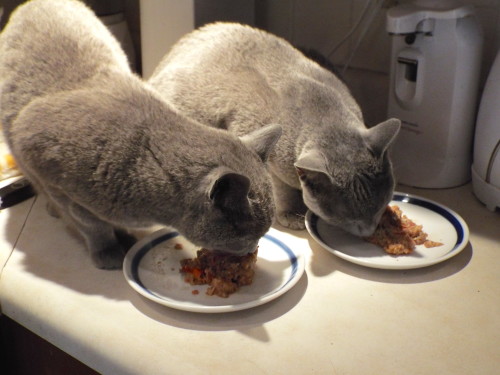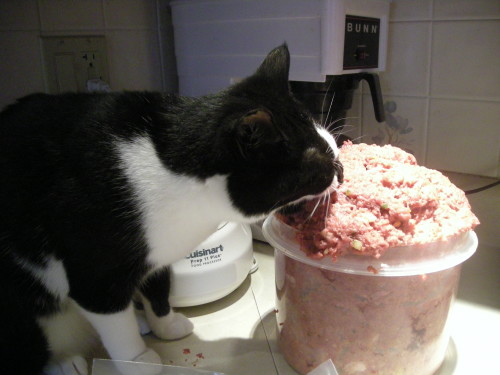My Journey to Raw: I wanted to do better!
This post is part of our “Journey to Raw” series, published every Wednesday, and describes how longtime journalist and cat expert Sally E. Bahner’s research led her to the discovery that processed pet foods really can’t compare to fresh, whole foods. Sally is a member of the Cat Writers’ Association and the International Association of Animal Behavior Consultants, and author of Exclusively Cats.

Sophie and Ashley.
My cats have been fed a raw, homemade diet for 15 years or so. Several kittens have been raised on it and several adults have been introduced to it mid-stream.
Two factors contributed to my interest in feeding a more species-appropriate diet.
First, my job as editor-in-chief of The Whole Cat Journal in the late ‘90s led me to investigate higher quality foods for cats. Like many people, I had thought my cats were receiving optimum nutrition, but I soon learned otherwise. Remember, this was even before the pet food recalls of 2007 heightened consumer awareness. It was also when foods like Wellness made their debut, and were considered the gold standard for feline nutrition.
Back then, there were few manufacturers of premade raw foods. Steve’s, Aunt Jeni’s, Pat McKay’s, Bravo, and Oma’s Pride are five that come to mind and they’re still in business.
Second, was a mysterious cough developed by my cat, Ashley. In trying to get to the bottom of it, I looked into nutritional allergies and began to experiment with making my own food.
In general, however, everyone was in good health, of various ages and breeds. I had always fed a variety of foods, both canned and dry, brands that were considered premium for their time. (Operative words: “for their time.”) But I was curious and felt I could do better.
I wanted a recipe that would accommodate my rather large feline family at that time, be doable given my work schedule, convenient, and, of course, balanced. It’s a recipe I still pretty much use today with some tweaking here and there.
In the course of my research and transitioning, my Russian Blue, Sophie, acquired mammary cancer. I redoubled my research into nutrition and supplements that could help her. To that end she lived for 16-½ months. She had three surgeries to de-bulk the tumors, but she didn’t have chemotherapy. She maintained good weight and body mass until the end. At one point, when the veterinarian was examining her, he said, “Gee, she doesn’t look like a cancer kitty!”
Hemmie was a stray of indeterminate age when we adopted her. We thought she may have been around 7 years old, and she was with us for 10 years. In her later years, she became hyperthyroid, which was managed nicely with methimazole, and she developed kidney problems as a result. That’s when I learned that it’s the quality of the protein, not the amount, that’s important. She, too, did well for quite some time, and I attribute that to the quality of her diet.
What can make raw feeding intimidating is the many variations on a theme: whole prey, grind your own, pre-made, freeze dried. I settled on a base of mix of gizzards, hearts, and a little bit of veggie, plus ground meat from the supermarket (chicken, turkey, occasionally pork), and supplements that included calcium, taurine, fish oil, Vitamin B-complex, and a spoonful of Udo’s Cat Essentials.
Three or four times a year we do a “big grind” in our trusty Cuisinart for the base mix and freeze 60 or 70 baggies. One batch gets me through about four meal-times with the three cats I have now (fed three times a day); it takes about five minutes to make a fresh batch of food.
It works for me. All three of my current cats have been raised on raw. Their weights are perfect. Their stools are very small and odorless. Blood work is fine in the oldest kitty. They are inside-only and minimally vaccinated.
Specifically, Tekla, who is 12-1/2, just passed her senior panel with flying colors and has no sign of kidney failure so common in older cats; she’s my oldest raw-fed kitty.

Mollie
And, I often hold up Mollie as an example. She was adopted as a scrawny little shelter kitty. We started her on raw immediately and we swear we could see her grow right before our eyes.
Our newbie, Celica Blue, transitioned to raw immediately. In fact, she even turns her little nose up at canned food, considered a delicacy by Tekla and Mollie.
Best of all, no one is food obsessed, which tells me that they are satisfied. They do not wake me at 5 a.m. looking for breakfast or meow incessantly between meals, although they’re at the ready come mealtime. They are fed three times a day – morning, evening, and bedtime. Celica Blue, however, has been known to snatch a defrosting bag of base mix off the counter and drag it into the other room.
Transitioning over the years has been pretty easy. A schmear of canned food or a sprinkle of freeze-dried chicken is usually enough to generate interest. Die-hard kibble heads might be persuaded with a topping of some ground up dry food.
My veterinarians have never criticized me (openly!) for feeding a raw diet. In fact, one asked me for information when he was dealing with a problematic case.
I always encourage people to do their homework when they ask about a raw diet for their cats. Fifteen years ago, there were few resources. Today, the Internet is brimming with help for people looking to transition their cats. Many veterinarians are on board and there is a host of talented, knowledgeable amateurs. Make use of them before you take the plunge.
You’ll never look at a bowl of kibble the same way again.
If you feed a home-prepared raw menu to your kitties and would like to see your story featured here, please contact us via Facebook private message through our page or our group, or leave a comment below!
And if you’re interested in giving raw a try for yourself, check out our extensive Raw Feeding and Transitioning Your Cat to Raw sections!
If you enjoyed this post or found it informative, please “Like” it, “Tweet” it, or share it using any of the buttons below. And don’t forget to check out our FB page, join the discussions in our awesome FB group and follow us on Twitter!

